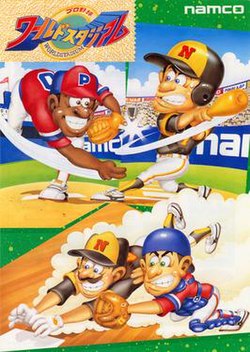Super World Stadium '96
| World Stadium series | |
|---|---|
 |
|
| Developer(s) | Namco |
| Publisher(s) | Namco |
| Platform(s) | Arcade |
| Release date(s) |
|
| Genre(s) | Sports game |
| Mode(s) | 2 players can play simultaneously |
| Cabinet | Upright, cabaret, and cocktail |
| Arcade system | Namco System 1 (1988-90), Namco System 2 (1991-93), Namco NB-1 (1995-97), Namco System 12 (1998-2001) |
| CPU | 2x Motorola M6809 @ 2.048 MHz, 1x Motorola M6809 @ 1.536 MHz, 1x Hitachi HD63701 @ 1.536 MHz (1988-90), 2x Motorola 68000 @ 12.288 MHz, 1x Motorola M6809 @ 3.072 MHz, 1x Hitachi HD63705 @ 2.048 MHz (1991-93), 1x Motorola 68000 @ 12.5 MHz (1995-97), 1x PSX CPU @ 16.9344 MHz (1998-2001) |
| Sound | 1x Yamaha YM2151 @ 3.57958 MHz (1988-93), 1x Namco CUS30 @ 96 kHz (1988-90), 1x DAC (1988-90), 1x C140 @ 21.39 kHz (1991-93), 1x C352 @ 16.384 MHz (1995-2001) |
| Display | Horizontal orientation, Raster, 288 x 224 resolution (1988-97), 640 x 480 resolution (1998-2001) |
World Stadium (full title: Pro Yakyū World Stadium プロ野球ワールドスタジアム (Puro Yakyū Wārudo Sutajiamu?)), is a series of baseball arcade games that were released by Namco in the late 1980s and 1990s exclusively in Japan; they were inspired by the 1986 Famicom game Pro Yakyū Family Stadium, and its sequel game, Pro Yakyū Family Stadium '87.
The first three titles in the series, World Stadium ワールドスタジアム (Wārudo Sutajiamu?) (1988), World Stadium '89 Kaimakuban ワールドスタジアム'89開幕版 (Wārudo Sutajiamu '89 Kaimakuban?) (1989) and World Stadium '90 ワールドスタジアム'90 (Wārudo Sutajiamu '90?) (1990), ran upon Namco System 1 hardware, and featured twelve teams from the "Urban League" (the Giants, Cars, Drasans, Sparrows, Wheels, and Titans), and "Country League" (the Lionels, Bravos, Hornets, Fires, Orients, and Buckaroos); they also featured three stadiums for matches to take place in (Kōrakuen, Kōshien and Mejā). The first two of these stadiums' scoreboards had clocks which started at 6:00 and advanced as the matches progressed (but broke at midnight), and the third stadium's scoreboard also featured the logo of Namco's United States distributor of that time period - Atari Games.
...
Wikipedia
